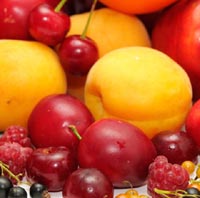Healthy Eating for Teenagers

Teenagers will eat junk food when they get the chance. That is a fact! It’s therefore essential to encourage healthy eating habits at home to set a good pattern for the future. Develop a five-a-day fruit and vegetable habit and fill up with whole grains and lean protein. This will leave less room for fatty and sugary foods. There are some key nutrients that teenagers require, nutrients that are often lacking in a young person’s diet. A deficiency in any of them can lead to tiredness, low energy, acne, increased susceptibility to illness, constipation and moodiness.
Carbohydrates are our main source of energy and play an important role in the functioning of the nervous system, muscles, and internal organs. Carbohydrate foods include fruits, vegetables, whole grains, and beans. The foods one should eat in limited amounts are ones that contain sugar, such as packaged cookies, cakes, soda. These sugars are called simple carbohydrates; they have a negative effect on one’s blood sugar levels and on one’s mood.
Protein is a primary component of the muscles, hair, nails, skin, eyes, and internal organs, especially the heart and brain. Protein is needed for growth, for healthy red blood cells, and much more. Protein foods include eggs, cheese, soy products (soymilk, tofu, miso, tempeh), fish, beans, nuts, seeds, chicken, turkey, beef, and pork.
Fats are a form of energy reserve and insulation in the human body, and can be burned to make energy when a person doesn’t get enough from his diet. Fats transport nutrients such as vitamins A, D, E, and K through the body and fatty tissue protects the vital organs from trauma and temperature change.
Simply put, there are “good” fats and “bad” fats. The “bad” fats are called saturated fats and are found in animal products, meats, and dairy foods; they should be eaten in limited amounts. These fats solidify at room temperature. Hydrogenated fats, sometimes called “transfatty acids” are also bad fats that are known to lead to heart disease and cancer. These hydrogenated fats are used in many packaged baked goods and margarines.
The “good” fats include the omega-3 and omega-6 fatty acids. Deficiencies of omega-3 fatty acids are linked to decreased learning ability and depression. These fats need to be obtained from your food. Good sources of the omega-3’s include flax oil, ground flaxseed, cold water fish like salmon and fresh tuna, canola oil, walnuts, and pumpkin seeds. Other “good” fats to include in your diet are found in olive oil, avocados, and grapeseed oil.
Iron is an extremely important mineral during puberty, especially for girls. Low levels can affect concentration, the ability to study and exam performance. Iron also prevents anemia and helps the body resist infection. Good sources of iron include dried fruit, spinach, parsley, poultry, organic liver, red meat, red lentils, eggs, sardines, and whole-grain rice.
Low magnesium levels are common in teenagers. Magnesium is essential for antibody production as well as for the proper functioning of the thymus gland. The adrenal glands also need this mineral for effective stress management. A deficiency may worsen premenstrual symptoms and increase allergic reactions. Magnesium-rich foods include nuts, seeds, green leafy vegetables, root vegetables, egg yolks, whole grains and dried fruit.
Vitamin E, found in avocados, nuts, seeds, vegetable oils, wheat germ and oatmeal, and vitamin A, found in carrots, leafy greens, apricots and sweet potatoes, are antioxidants necessary to increase resistance to infections. They are also required to keep skin healthy. Citrus fruit (such as oranges and lemons), tomatoes and potatoes are all good sources of vitamin C, which is essential for health. Vitamin C may help the absorption of iron.
A good intake of zinc helps to clear the skin, and this mineral is also essential for the maturation of sex hormones and is an antiviral antioxidant needed for growth and development of white blood cells, part of the immune army. Poultry, game, lean red meat, nuts, seeds, shellfish, sardines, mackerel, liver, wheat germ and whole grains are particularly rich in zinc.
Adolescents need to keep their calcium levels up, as the amount they consume helps determine the bone strength in later life. Milk, cheese, eggs, canned fish, nuts, seeds, and dark green leafy vegetables, all contain good levels of calcium. Avoiding fizzy cold drinks is also advisable, as the phosphoric acid in these drinks helps leach the calcium out of the bones, making them weaker.
Fortified breakfast cereals, margarine and oily fish are good sources of dietary vitamin D, which the body needs to absorb calcium. The main source of vitamin D is from the action of sunlight on skin, but avoid strong sun especially around midday when there is a risk of burning.
|